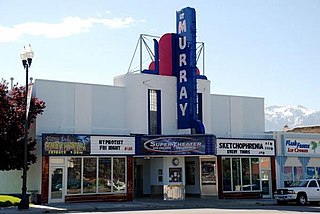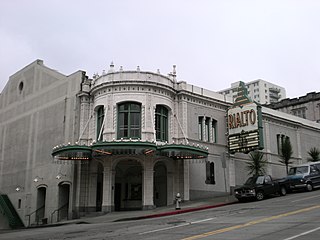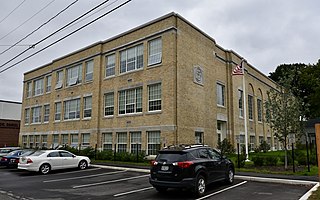
The Murray Theater is a theater located in Murray, a suburb of Salt Lake City, Utah. It is listed on the National Register of Historic Places, and is one of the area's best examples of the Art Moderne style in theater architecture. The theater operated as both a first-run and second-run venue for motion pictures, and has been extensively renovated and redesigned during its history.

The Bank Building was a historic commercial building located at 40-44 South Street, in Uxbridge, Massachusetts. Until its destruction by fire in 2013, it was the best-preserved of Uxbridge's 19th century commercial buildings. It was built in 1895–96, and was listed on the National Register of Historic Places in 1983.

The Rialto Theatre in Tacoma, Washington was built in 1918 to showcase movies. Its design reflects the affluence following World War I. It reflects the character of a palace and is the result of efforts by entrepreneur Henry T. Moore and Tacoma architect Roland E. Borhek. Designed to hold 1500 patrons and retail space. The two-and-a-half-story structure is in the historic downtown of Tacoma. The area has long been associated with theaters and entertainment. The theater is freestanding, with a dramatic view on an incline with a classical façade sheathed of glazed white terra cotta. Both the interior and exterior retain most of the original design of Roland E. Borhek. The theater has an auditorium, proscenium with stage, a relocated projection booth, balcony, lobby, and commercial space. It has been altered with the removal of the storefronts and marquee. On the inside, the lobby's decorative ceiling has been hidden and the concession areas expanded.

The Ruby Theater is a small movie theater located in Chelan, Washington. Built in 1914, it was named after Ruby Potter, the step-daughter of its manager, Frank Potter. The original owners were Herbert R. Kingman and Morrison M. Kingman. Original seating capacity was 225 on the main level and 125 in the balcony. The theater was equipped as a cinema and as a vaudeville house. With the exception of 1972-1974, the Ruby has been showing movies for over ninety years, and is one of the oldest movie theaters in Washington.

The Jefferson–Chalmers Historic Business District is a historic district located on East Jefferson Avenue between Eastlawn Street and Alter Road in Detroit, Michigan. The district is the only continuously intact commercial district remaining along East Jefferson Avenue, and was listed on the National Register of Historic Places in 2004.

The Rivoli Theatre in South Fallsburg, New York, United States is located at the intersection of NY 42 and Laurel Avenue. It was built in 1923, renovated in the late 1930s and remains almost intact from that period.

The William J. Nealon Federal Building and United States Courthouse is a courthouse of the United States District Court for the Middle District of Pennsylvania, located in Scranton, Pennsylvania. It was completed in 1931, and was listed on the National Register of Historic Places in 2018.

The U.S. Forest Service Building is a historic building in Ogden, Utah owned by the United States federal government. Located at 507 25th Street, it is listed as a Historic Federal Building, and was constructed during the years 1933–1934. Its primary task was to provide offices for the U.S. Forest Service Intermountain Region, the Experimental Station, and the Supply Depot. The building was listed on the National Register of Historic Places in 2006.

The Quincy Street Historic District is a historic district located along the 100, 200, and 300 blocks of Quincy Street, along with 416 Tezcuco Street, in Hancock, Michigan. The Hancock Town Hall and Fire Hall is located in the district. The district was listed on the National Register of Historic Places in 1988.

The Mississippi Lofts and Adler Theatre is an apartment building and theater complex located in downtown Davenport, Iowa, United States. It is individually listed on the National Register of Historic Places by its original name, the Hotel Mississippi-RKO Orpheum Theater. The Hotel Mississippi was listed on the Davenport Register of Historic Properties in 2005. In 2020 the complex was included as a contributing property in the Davenport Downtown Commercial Historic District.

The Eureka Theater is an Art Moderne–style cinema built in 1939 in Eureka, California. The movie theater was initially proposed in 1937 as part of a larger development that would include a five-story, 162-room hotel, which was soon scaled back to the theater with flanking commercial spaces. Built by theater magnate George M. Mann, the theater was designed by noted San Francisco designer William B. David, who had once worked in the Metro-Goldwyn-Mayer Art Department in the mid-1930s. The Eureka Theater was considered an ultra-modern movie theater when constructed in 1939 and was an expression of optimism and confidence in Eureka and Humboldt County, California as they pulled out of the Depression. The Eureka Theater ceased showing regularly scheduled movies on August 1, 1996. The theater is currently undergoing restoration, and is available for rent as a performance or event venue.

Pitts Theatre, also known as the State Theatre after 1970, is a historic movie theater located at Culpeper, Culpeper County, Virginia. It was built in 1937–1938, and is a concrete block structure faced in brick in the Art Deco style. The building consists of a symmetrical three-bay façade, with a central theater entrance flanked by storefront retail spaces. The façade features a stepped massing that recedes from the entrance and storefronts. The interior has a sophisticated circulation system, which enabled balcony patrons, which were initially African-American, and white patrons to enter the theater separately to separate spaces; the main balcony and auditorium, respectively. The theater closed in 1992.

The Northrup Theater was built in Syracuse, Kansas in 1930 by local businessman Frank F. Northrup. At the time of its construction it was billed as the largest movie theater in western Kansas. The theater continues to show movies, and is owned by the Syracuse/Hamilton Chamber of Commerce.

The Mahaiwe Block is a commercial and theater building in the heart of downtown Great Barrington, Massachusetts. In addition to smaller businesses, it houses the Mahaiwe Performing Arts Center, the town's only major performance space. It has been in virtually continuous operation since its construction in 1905. The building is located at 6-14 Castle St. and 314-322 Main St, and is listed on the National Register of Historic Places.

The Criterion Theatre is a historic performance space at 35 Cottage Street in downtown Bar Harbor, Maine. Built in 1932 when Bar Harbor's summer scene was at its height, it is one of only two Art Deco theaters in the state of Maine. The theatre has in recent years struggled for financial solvency but was purchased in 2014 by a nonprofit organization. After a major renovation, the theater reopened for business in May 2015. It was listed on the National Register of Historic Places in 1980.

The Old Brewer High School is a historic school building at 5 Somerset Street in Brewer, Maine. Built in 1925-26, this Art Deco building was built to meet the ideals of the time for what a high school should be. The building was listed on the National Register of Historic Places in 2014.

The Kresge Block is a historic commercial building at 241-249 Water Street in downtown Augusta, Maine. Built in 1932 to house a department store, it is a distinctive and rare local example of commercial Moderne architecture. It was listed on the National Register of Historic Places in 1986.

The Strand Theatre is a historic performing arts venue at 345 Main Street in downtown Rockland, Maine. Built in 1923 in the wake of a fire that destroyed part of the downtown, it is a rare example of Egyptian Revival architecture, and the only one of three theaters built in Rockland in that period to survive. Now owned by a non-profit, it continues to present films as well as musical and theatrical productions. It was listed on the National Register of Historic Places in 2004.

The New Center Commercial Historic District is a commercial historic district located on Woodward Avenue between Baltimore Street and Grand Boulevard in Detroit, Michigan. It was listed on the National Register of Historic Places in 2016.

Esquire Theater is a historic movie theater located at Cape Girardeau, Missouri. It was built in 1946–1947, and is a two-story, brick building with a colorful Art Deco facade. The building measures approximately 100 feet by 60 feet. It features a projecting marquee with neon tube lights; a streamlined, curving entrance and ticket booth; a projecting proscenium-like arch; and embellishments including enameled and stainless steel, structural pigmented glass, marble and glass blocks.





















